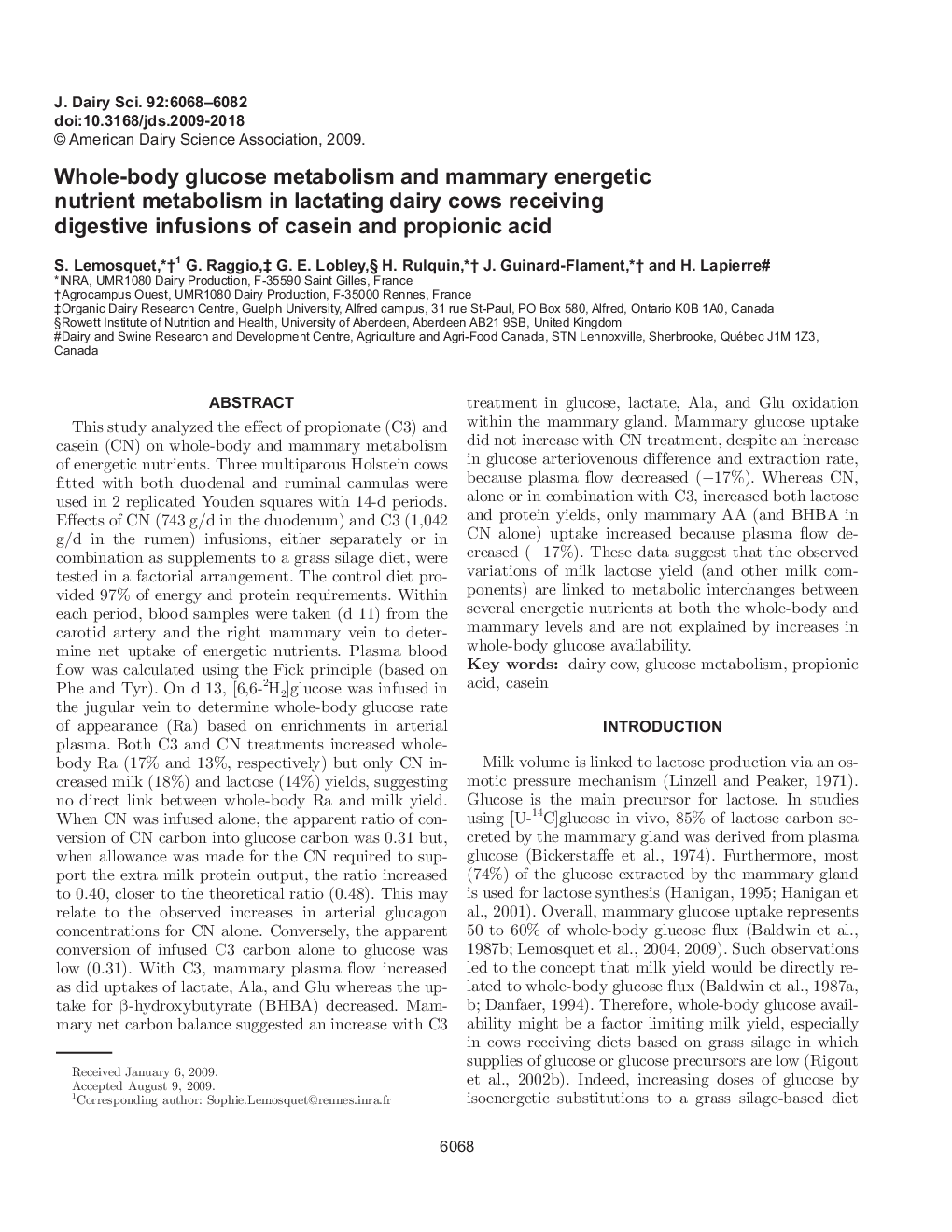| کد مقاله | کد نشریه | سال انتشار | مقاله انگلیسی | نسخه تمام متن |
|---|---|---|---|---|
| 2438949 | 1108082 | 2009 | 15 صفحه PDF | دانلود رایگان |
عنوان انگلیسی مقاله ISI
Whole-body glucose metabolism and mammary energetic nutrient metabolism in lactating dairy cows receiving digestive infusions of casein and propionic acid
دانلود مقاله + سفارش ترجمه
دانلود مقاله ISI انگلیسی
رایگان برای ایرانیان
کلمات کلیدی
موضوعات مرتبط
علوم زیستی و بیوفناوری
علوم کشاورزی و بیولوژیک
علوم دامی و جانورشناسی
پیش نمایش صفحه اول مقاله

چکیده انگلیسی
This study analyzed the effect of propionate (C3) and casein (CN) on whole-body and mammary metabolism of energetic nutrients. Three multiparous Holstein cows fitted with both duodenal and ruminal cannulas were used in 2 replicated Youden squares with 14-d periods. Effects of CN (743 g/d in the duodenum) and C3 (1,042 g/d in the rumen) infusions, either separately or in combination as supplements to a grass silage diet, were tested in a factorial arrangement. The control diet provided 97% of energy and protein requirements. Within each period, blood samples were taken (d 11) from the carotid artery and the right mammary vein to determine net uptake of energetic nutrients. Plasma blood flow was calculated using the Fick principle (based on Phe and Tyr). On d 13, [6,6-2H2]glucose was infused in the jugular vein to determine whole-body glucose rate of appearance (Ra) based on enrichments in arterial plasma. Both C3 and CN treatments increased whole-body Ra (17% and 13%, respectively) but only CN increased milk (18%) and lactose (14%) yields, suggesting no direct link between whole-body Ra and milk yield. When CN was infused alone, the apparent ratio of conversion of CN carbon into glucose carbon was 0.31 but, when allowance was made for the CN required to support the extra milk protein output, the ratio increased to 0.40, closer to the theoretical ratio (0.48). This may relate to the observed increases in arterial glucagon concentrations for CN alone. Conversely, the apparent conversion of infused C3 carbon alone to glucose was low (0.31). With C3, mammary plasma flow increased as did uptakes of lactate, Ala, and Glu whereas the uptake for β-hydroxybutyrate (BHBA) decreased. Mammary net carbon balance suggested an increase with C3 treatment in glucose, lactate, Ala, and Glu oxidation within the mammary gland. Mammary glucose uptake did not increase with CN treatment, despite an increase in glucose arteriovenous difference and extraction rate, because plasma flow decreased (â17%). Whereas CN, alone or in combination with C3, increased both lactose and protein yields, only mammary AA (and BHBA in CN alone) uptake increased because plasma flow decreased (â17%). These data suggest that the observed variations of milk lactose yield (and other milk components) are linked to metabolic interchanges between several energetic nutrients at both the whole-body and mammary levels and are not explained by increases in whole-body glucose availability.
ناشر
Database: Elsevier - ScienceDirect (ساینس دایرکت)
Journal: Journal of Dairy Science - Volume 92, Issue 12, December 2009, Pages 6068-6082
Journal: Journal of Dairy Science - Volume 92, Issue 12, December 2009, Pages 6068-6082
نویسندگان
S. Lemosquet, G. Raggio, G.E. Lobley, H. Rulquin, J. Guinard-Flament, H. Lapierre,